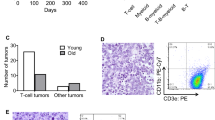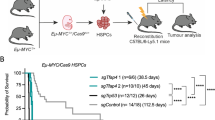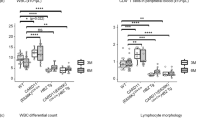Abstract
Severe combined immunodeficiency (SCID) mice1 are defective in their ability to rearrange their variable (V), diversity (D) and joining (J) genetic elements to generate functional immunoglobulin (Ig) and T-cell receptor (TCR) molecules; as a result, they lack mature B and T cells2. These mice are highly sensitive to ionizing radiation, suggesting that the product of the scid gene plays a critical role in both V(D)J recombination and DMA double-strand break repair3–5. Recent studies suggest that the SCID defect lies in the gene encoding the catalytic subunit of DMA-dependent protein kinase (DNA-PK; refs 6–8), a nuclear protein made up of the Ku 70 and Ku 86 subunits as well as the large catalytic subunit, DNA-PKcs9,10. Other reports have implied that the SCID phenotype correlates with nonsense mutations at the extreme 3′ end of Prkdc, the DNA-PKcs gene11–14. The identity of the gene remains in doubt, however, because the consequences of genetic inactivation of Prkdc have not been determined. This study shows that complete inactivation of Prkdc in a novel insertional mouse mutant recapitulates the SCID phenotype and that Prkdc and scid are allelic. Significantly, DNA-PKcs null mice demonstrate complete penetrance of thymic lymphoblastic lymphomas, strongly suggesting that Prkdc functions in mice as a T-cell tumour suppressor and, by virtue of its association with DNA repair and recombination, belongs to the ‘caretaker’ class of tumour-suppressor genes that includes ATM, BRCA1 and BRCA2(ref.15).
This is a preview of subscription content, access via your institution
Access options
Subscribe to this journal
Receive 12 print issues and online access
$209.00 per year
only $17.42 per issue
Buy this article
- Purchase on Springer Link
- Instant access to full article PDF
Prices may be subject to local taxes which are calculated during checkout
Similar content being viewed by others
References
Bosma, G.C., Custer, R.P. & Bosma, M.J. A severe combined immunodeficiency mutation in the mouse. Nature. 301, 527–530 (1983).
Gellert, M. Recent advances in understanding V(D)J recombination. Adv. Immunol. 64, 39–64 (1997).
Fulop, G.M. & Phillips, R.A. The scid mutation in mice causes a general defect in DNA repair. Nature. 347, 479–482 (1990).
Biedermann, K.A., Sun, J.R., Giaccia, A.J., Tosto, L.M. & Brown, J.M. Scid mutation in mice confers hypersensitivity to ionizing radiationand a deficiency in DNA double-strand break repair. Proc. Natl. Acad. Sd. USA 88, 1394–1397 (1991).
Hendrickson, E.A. et al. A link between double-strand break-related repair and V(D)J recombination: the scid mutation. Proc. Natl. Acad. Sci. USA. 88, 4061–4065 (1991).
Blunt, T. et al. Defective DNA-dependent protein kinase activity is linked to V(D)J recombination and DNA repair defects associated with the murine scid mutation. Cell 80, 813–823 (1995).
Kirchgessner, C.U. et al. DNA-dependent kinase (p350) as a candidate gene for the murine SCID defect. Science 267, 1178–1183 (1995).
Peterson, S.R. et al. Loss of the catalytic subunit of the DNA-dependent protein kinase in DNA double-strand-break-repair mutant mammalian cells. Proc. Natl. Acad. Sci. USA 92, 3171–3174 (1995).
Gottlieb, T.M. & Jackson, S.P., The DNA-dependent protein kinase: requirement for DNA ends and association with Ku antigen. Cell 72, 131–142 (1993).
Zhu, C., Bogue, M.A., Lim, D.S., Hasty, P., & Roth, D.B. Ku86-deficient mice exhibit severe combined immunodeficiency and defective processing of V(D)J recombination intermediates. Cell 86, 379–389 (1996).
Blunt, T. et al. Identification of a nonsense mutation in the carboxyl-terminal region of DNA-dependent protein kinase catalytic subunit in the scid mouse. Proc. Natl. Acad. Sci. USA 93, 10285–10290 (1996).
Danska, J.S., Holland, D.P., Mariathasan, S., Williams, K.M. & Guidos, C.J. Biochemical and genetic defects in the DNA-dependent protein kinase in murine scid lymphocytes. Mol. Cell. Biol. 16, 5507–5517 (1996).
Araki, R. et al. Nonsense mutation at Tyr-4046 in the DNA-dependent protein kinase catalytic subunit of severe combined immune deficiency mice. Proc. Natl. Acad. Sci. USA 94, 2438–2443 (1997).
Shin, E.K., Perryman, L.E. & Meek, K. A kinase-negative mutation of DNA-PK(CS) in equine SCID results in defective coding and signal joint formation.J. Immunol. 158, 3565–3569 (1997).
Kinzler, K.W. & Vogelstein, B. Gatekeepers and caretakers. Nature. 386, 761–763 (1997).
Strada, S.J., Martin, M.W. & Thompson, W.J. General properties of multiple molecular forms of cyclic nucleotide phosphodiesterase in the nervous system. Adv. Cyclic Nucleotide Protein Phosphorylation Res. 16, 13–29 (1984).
Suoranta, K. & Londesborough, J. Purification of intact and nicked forms of a zinc-containing, Mg2+-dependent, low Km cyclic AMP phosphodiesterase from bakers' yeast. J. Biol. Chem. 259, 6964–6971 (1984).
Sarvetnick, N., Liggitt, D., Pitts, S.L., Hansen, S.E. & Stewart, T.A. Insulin-dependent diabetes mellitus induced in transgenic mice by ectopic expression of class II MHC and interferon-gamma. Cell 52, 773–782 (1988).
Jhappan, C. et al. TGFα overexpression in transgenic mice induces liver neoplasia and abnormal development of the mammary gland and pancreas. Cell 61, 1137–1146 (1990).
Miller, R.D. et al. Gene for the catalytic subunit of mouse DNA-dependent protein kinase maps to the scid locus. Proc. Natl. Acad. Sci. USA 92, 10792–10795 (1995).
Finnie, N.J., Gottlieb, T.M., Blunt, T., Jeggo, P.A. & Jackson, S.P. DNA-dependent protein kinase activity is absent in xrs-6 cells: implications for site-specific recombination and DNA double-strand break repair. Proc. Natl. Acad. Sci. USA 92, 320–324 (1995).
Anderson, C.W. & Lees-Miller, S.P. The nuclear serine/threonine protein kinase DNA-PK. Crit. Rev. Eukaryotic Gene Express. 2, 283–314 (1992).
Lees-Miller, S.P., Sakaguchi, K., Ullrich, S.J., Appella, E. & Anderson, C.W., Human DNA-activated protein kinase phosphorylates serines 15 and 37 in the amino-terminal transactivation domain of human p53. Mol. Cell. Biol. 12, 5041–5049 (1992).
Hartley, K.O. et al. DNA-dependent protein kinase catalytic subunit: a relative of phosphatidylinositol 3-kinase and the ataxia telangiectasia gene product. Cell 82, 849–856 (1995).
Nussenzweig, A. et al. Requirement for Ku80 in growth and immunoglobulin V(D)J recombination. Nature. 382, 551–555 (1996).
Carroll, A.M., Hardy, R.R. & Bosma, M.J. Occurrence of mature B (IGM+, B220+) and T (CD3+) lymphocytes in scid mice. J. Immunol. 143, 1087–1093 (1989).
Custer, R.P., Bosma, G.C. & Bosma, M.J. Severe combined immunodeficiency (SCID) in the mouse: pathology, reconstitution, neoplasms. Am. J. Pathol. 120, 464–477 (1985).
Savitsky, K. et al. A single ataxia telangiectasia gene with a product similar to Pl-3 kinase. Science. 268, 1749–1753 (1995).
Hakem, R. et al. The tumor suppressor gene Brcal is required for embryonic cellular proliferation in the mouse. Cell 85, 1009–1023 (1996).
Sharan, S.K. et al. Embryonic lethality and radiation hypersensitivity mediated by Rad51 in mice lacking Brca2. Nature 386, 804–810 (1997).
Author information
Authors and Affiliations
Rights and permissions
About this article
Cite this article
Jhappan, C., Morse, H., Fleischmann, R. et al. DNA-PKcs: a T-cell tumour suppressor encoded at the mouse scid locus. Nat Genet 17, 483–486 (1997). https://doi.org/10.1038/ng1297-483
Received:
Accepted:
Issue Date:
DOI: https://doi.org/10.1038/ng1297-483
This article is cited by
-
Patient-derived xenografts as compatible models for precision oncology
Laboratory Animal Research (2020)
-
Dendritic cells induce Th2-mediated airway inflammatory responses to house dust mite via DNA-dependent protein kinase
Nature Communications (2015)
-
Recruitment and activation of the ATM kinase in the absence of DNA-damage sensors
Nature Structural & Molecular Biology (2015)
-
rAAV-Mediated Tumorigenesis: Still Unresolved After an AAV Assault
Molecular Therapy (2012)
-
Ability to repair DNA double-strand breaks related to cancer susceptibility and radiosensitivity
Radiation Medicine (2007)



